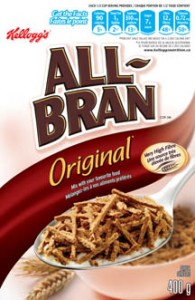比美国的食å“åœ¨åŠ æ‹¿å¤§å’¸?
 全麦就是全麦, å³?
全麦就是全麦, �
If you regularly eat a cereal like Kellogg’s All-Bran in the U.S., you’d assume that that cereal would taste the same in Canada.
Not according to a recent study by the group, 世界ç›ä¸Žå¥åº·è¡ŒåŠ¨ (WASH).
他们报告说, many popular foods, including Burger King’s onion rings and Special K cereal, åœ¨åŠ æ‹¿å¤§æœ‰æ›´å¤šçš„é’ æ¯”ä»–ä»¬åšçš„å—部边境.
Here’s more on what they found:
æœ€æ–°ç ”ç©¶è¡¨æ˜Žï¼Œ people in some countries are being fed over twice as much salt in popular global brands as their counterparts elsewhere in the world.
世界ç›ä¸Žå¥åº·è¡ŒåŠ¨ (WASH) has surveyed over 260 food products available around the world from food manufacturers such as KFC, 麦当劳, 家ä¹æ°å…¬å¸, è´´è¿‘, Burger King and Subway.  Not one product surveyed had the same salt content around the world and some displayed huge differences in salt content from one country to another.
å‡¯æ´›æ ¼çš„å…¨éº¦é¢åŒ…, 例如, contains 2.15g of salt per 100g in Canada, but only 0.65g of salt per 100g just over the border in the United States, less than a third of the Canadian level.
è¿™é¡ºåº æ±‰å ¡çŽ‹ï¼ˆBurger King)洋葱圈 有 681 åœ¨åŠ æ‹¿å¤§ï¼Œæ¯100å…‹æ¯«å…‹çš„é’ , ä½†å¦‚æžœä½ æ˜¯åœ¨ç¾Žå›½è®¢è´, the sodium content is 538 毫克æ¯100å…‹. åœ¨åŠ æ‹¿å¤§, 100å…‹ Special K cereal 有 931 毫克的ç›, 而在美国, the same portion of cereal contains 710 æ¯«å…‹çš„é’ .
In an article about the WASH study, entitled “ä½œä¸ºåŠ æ‹¿å¤§ä½œä¸ºç›,” çš„ 环çƒé‚®æŠ¥ 试图找出如何解释这些差异:
æ±‰å ¡çŽ‹å…¬å¸. did not respond to a request for comment, and no company contacted agreed to an interview on sodium. å‡ ä¸ª, including KFC Canada and McDonald’s Restaurants of Canada Ltd., declined an interview request but sent a statement via e-mail.
A McDonald’s Canada spokesman said the company reviews its menus frequently, while KFC Canada said sodium levels may be higher in one country than another due to consumer preference.
å‡¯æ´›æ ¼åŠ æ‹¿å¤§å…¬å¸. also declined an interview request, but said in an e-mail statement that “geographical variances in consumer taste preferences and ingredient supplies†explain why some of the company’s products contain different amounts of sodium in different countries. The company’s products contain “the minimum amount of sodium needed to meet consumers’ taste preference in new products,†according to an e-mail statement from Christine Lowry, vice-president of nutrition and corporate affairs.
For more on some of the differences between prepared foods in Canada and the U.S., have a look at our post, ä¸ºä»€ä¹ˆåœ¨åŠ æ‹¿å¤§çš„ä¸åŒå£å‘³çš„番茄酱?
And if you’re moving to Canada, ä½ å¯èƒ½è¦ä¸¾è¡Œçš„ç›!




















